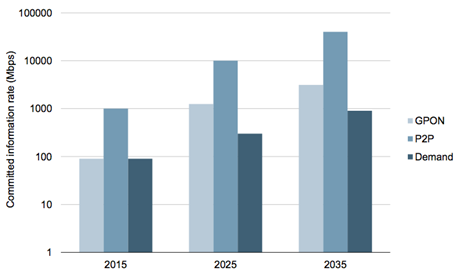Global consultancy Analysys Mason has forecast a ten-fold increase in user demand for broadband speeds over the next 20 years, reaching gigabit speeds to the home by 2030.

It said demand would largely be driven by rising interest in high-quality internet television services.
The claim was made as part of a technical review [pdf] of the National Broadband Network’s fibre and fixed wireless components. It was submitted by NBN Co to the competition watchdog this week.
The report sought to “provide independent advice on the efficiency and prudency of NBN Co’s design of its fibre and fixed wireless networks”, but not question choices mandated by the Government or the Australian Competition and Consumer Comission around the network technologies or design.
The firm said users would demand internet speeds of up to 90 Mbps by 2015 in order to provide two simultaneous, standard definition 3D television services and a concurrent internet service at 30 Mbps.
This would rise to 300 Mbps in 2025 to cater for faster internet services and two 3D television services in high definition, eventually reaching 900 Mbps to serve two “ultra-HD” television services (at four times current 1080p resolution) to a premises alongside a 300 Mbps internet connection.

NBN Co CEO Mike Quigley has previously pointed to potential demand for gigabit speeds by ‘cutting-edge users’ as early as the end of this decade.
The ongoing increase in user demand for bandwidth would prompt further upgrades to the NBN as it is rolled out.
Current passive optical networking (PON) equipment being installed as part of the NBN provides downlink speeds of up to 2.5 Gbps and half that for uploads, split between 16 or 32 houses.
NBN Co chief technology officer Gary McLaren told iTnews last year that the wholesaler’s product roadmap provided for equipment upgrades to 10 Gbps and ultimately 40 Gbps technologies over the next five years.
The Analysys Mason report argued the NBN network design could “have a sufficient upgrade path to meet the reasonably anticipated requirements of access seekers and end users for bandwidth over the next 30 years”.
However, it warned of potential technical obstacles to upgrading PON equipment.
“For example, new modulation, coding, transmitter, receiver and multiplexing products will have to be developed,” it said.
“Although most of these are already available for long-haul applications, different products need to be developed to meet mass-market price points.”


_(20).jpg&h=140&w=231&c=1&s=0)
_(22).jpg&h=140&w=231&c=1&s=0)





_(26).jpg&w=100&c=1&s=0)

 iTnews Executive Retreat - Security Leaders Edition
iTnews Executive Retreat - Security Leaders Edition












_(1).jpg&h=140&w=231&c=1&s=0)



